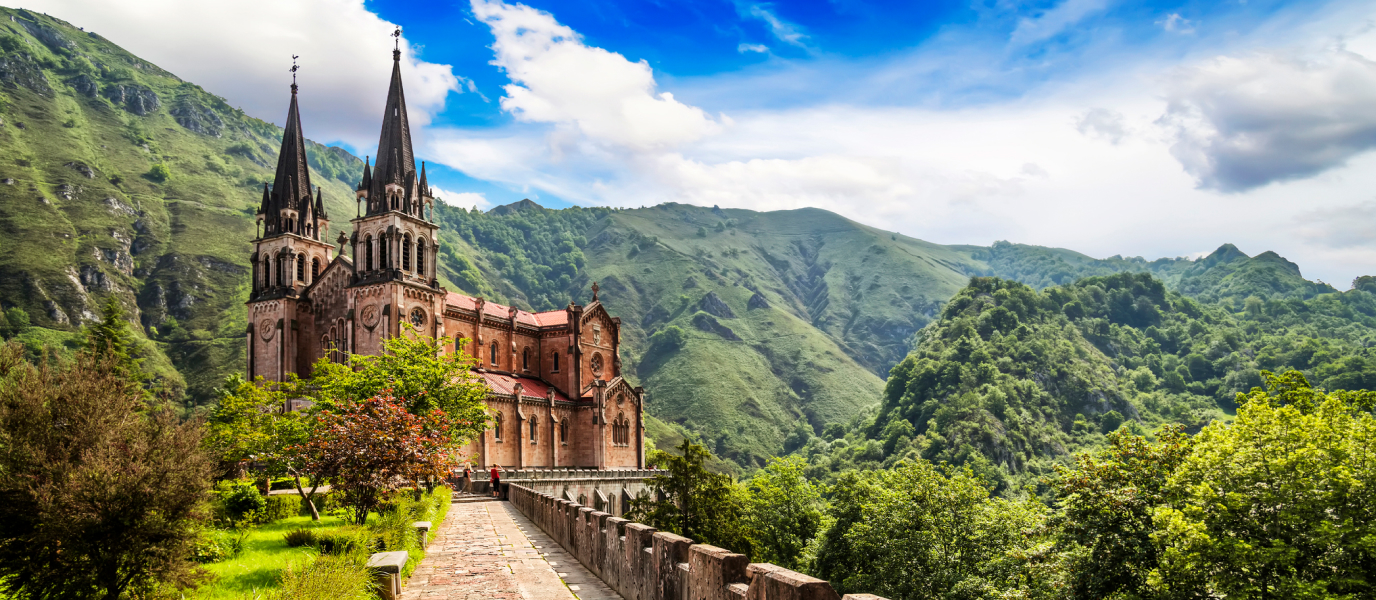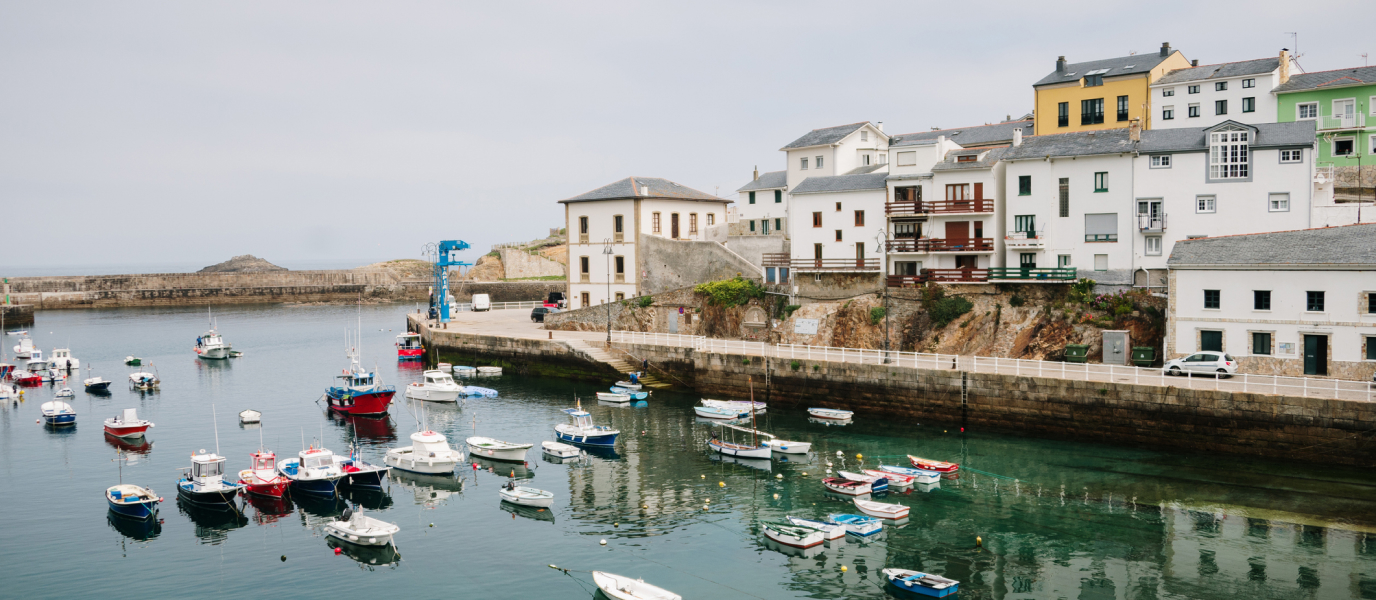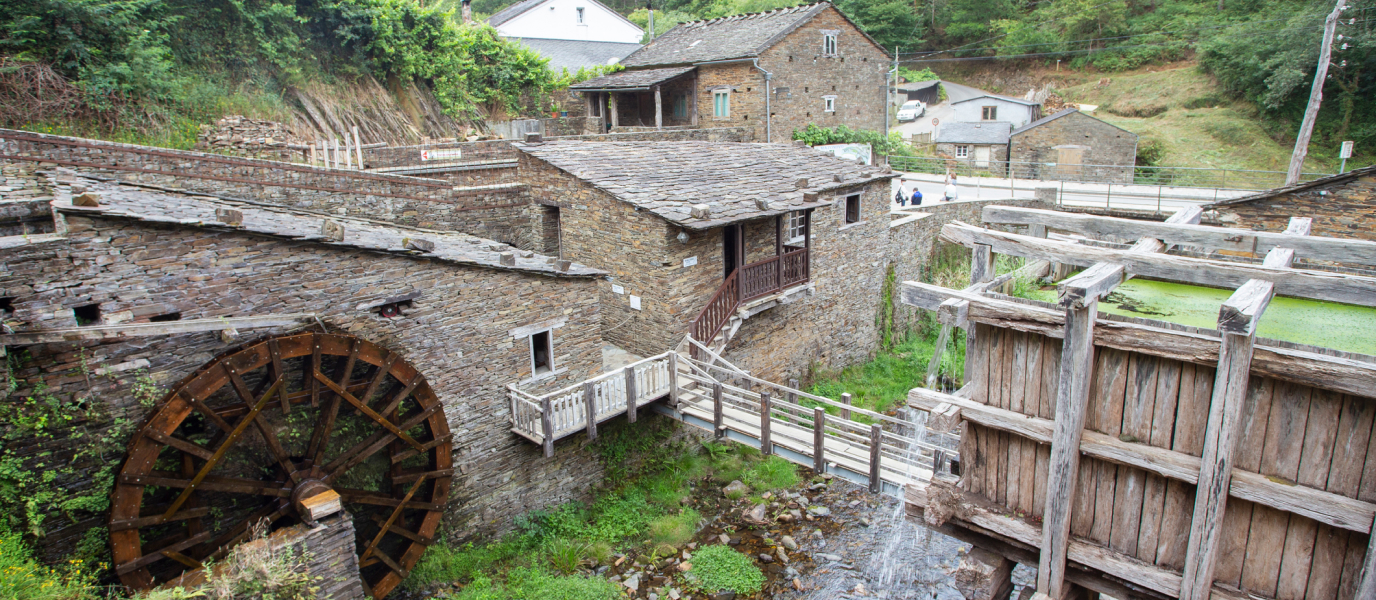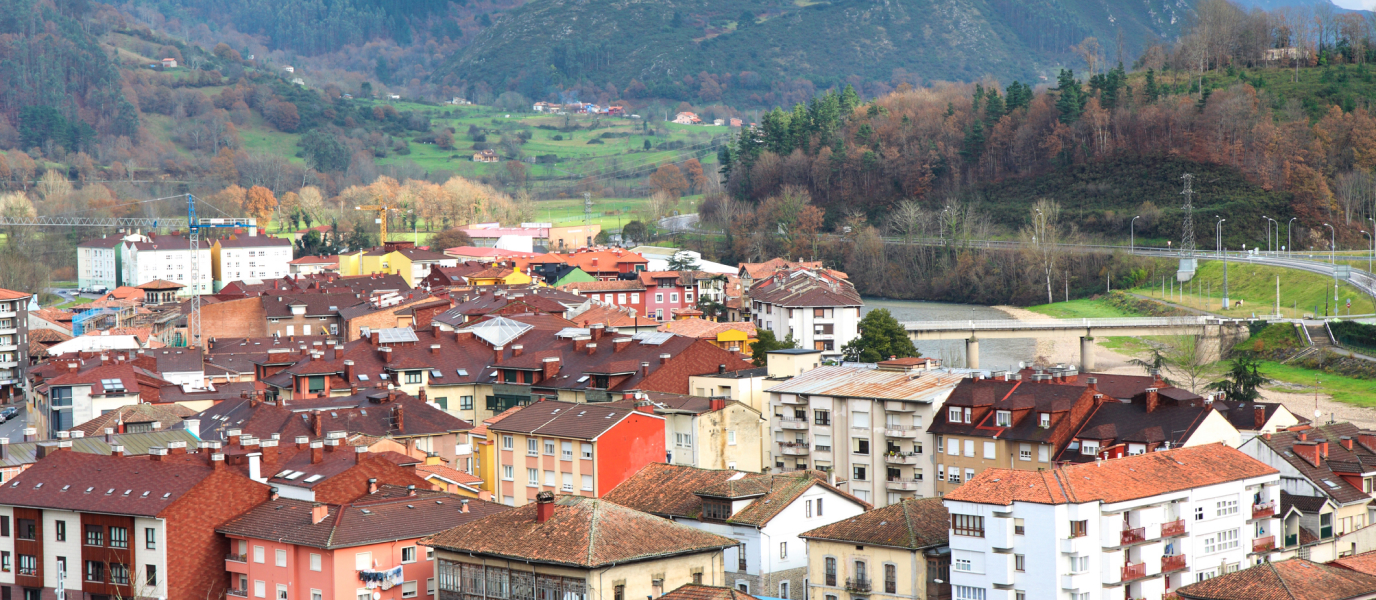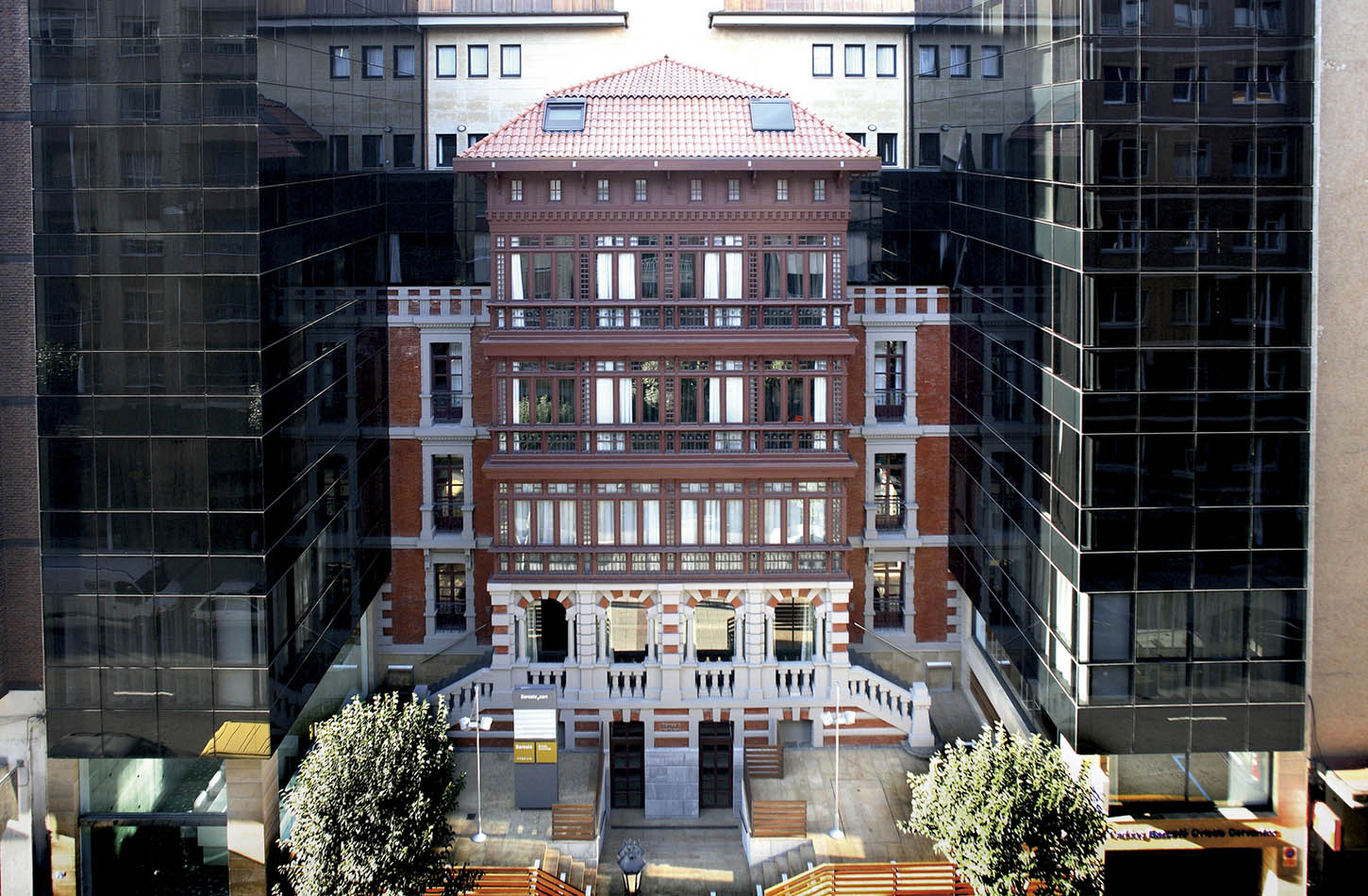Asturias is a wonderful land with much to offer visitors.
Its municipalities will win you over. The charm of the majestic city of Oviedo, the unique atmosphere of Gijón, the exceptional villages of Cudillero and Llanes, and the beaches surrounded by an incredible green landscape make Asturias an outstanding destination.
For nature lovers, it’s also a place certainly worth a visit, as it’s home to some of the most marvellous landscapes in Spain.
The Cares route, the Somiedo Natural Park, and the Tito Bustillo cave are just some of the essential stops. Not forgetting the lakes of Covadonga, the natural jewel in the crown of Asturias, within the Picos de Europa National Park, or some of its spectacular beaches, such as Silencio beach or Gulpiyuri beach, the smallest in the world.
Natural wonders not to be missed in Asturias
Related experiences
Lakes of Covadonga, a natural jewel in the Principality of Asturias
The lakes of Covadonga are one of the natural jewels in the Principality’s crown. They’re located in the municipality of Cangas de Onís and their main formations are two glacial lakes. In the depths of lake Enol, the larger of the two, an image of the Lady of Covadonga is submerged, and is taken out every 8 September to be carried as part of a procession. Slightly higher up, at an altitude of 1,100 metres, is the smaller lake Ercina. When the thaw occurs, a third lake appears, lake Bricial, which only contains water at that time of year.
A visit to this stunningly beautiful setting is usually combined with a visit to the Santa Cueva to greet the patron saint of Asturias. But there are so many options for hiking in this area that lovers of this activity usually come here more than just once. There are routes to suit all tastes, with various difficulty levels. One of the easiest, even for children, is a circular route of about six kilometres, which takes two hours to complete. This route passes through the Palomberu beech forest, the Buferrera mines, and the Príncipe viewpoint. From the viewpoint you can enjoy beautiful panoramic views. Another option to take in the magnificence of the landscape is the Entrelagos viewpoint.
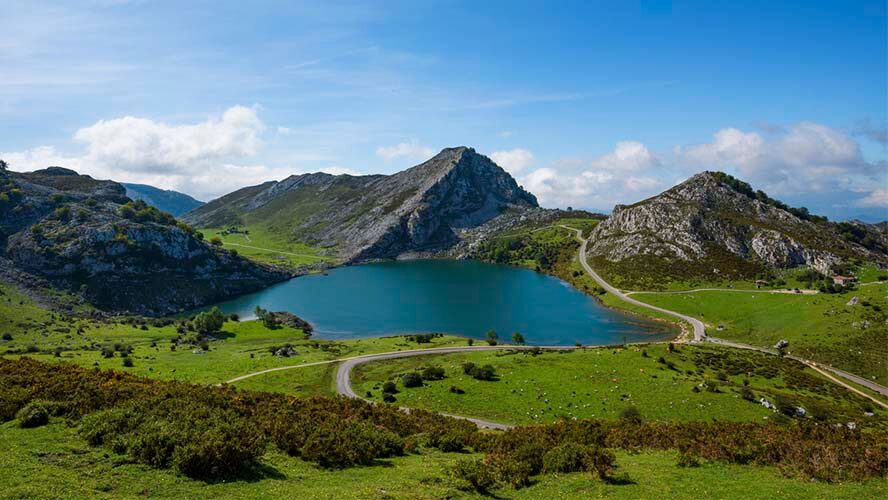
Sanctuary of Covadonga
Covadonga is a place full of symbolism because it was here that Don Pelayo defeated the Arabs who were occupying the region, which led to the beginning of the Reconquista period.
The religious complex of Covadonga is also one of the most visited pilgrimage sites in Spain by religious people. This complex includes several areas: the Santa Cueva, where the Lady of Covadonga, or “la Santina”, as she is known to locals is found, as well as the chapel, in Romanesque style, and the basilica of Covadonga. The basilica, built with pink marble stone obtained from the local mountains, is a stunning example of neo-Romanesque architecture. Both the temple and the route leading to it are very beautiful, and offer incredible views of the valley and the mountains.
The complex also includes La Casina, a place dedicated to prayer for the hundreds of faithful visitors who come here. And Casa de los Ejercicios, a retreat area where silence and spiritual activity are the norm. It has meeting rooms, chapels, and also rooms in which to spend a few days engaged in meditation.
History and spirituality permeate this area of the Principality of Asturias, and its natural beauty invites visitors to take to the trails. The surroundings of Covadonga are in the Asturian part of the Picos de Europa Nature Reserve.
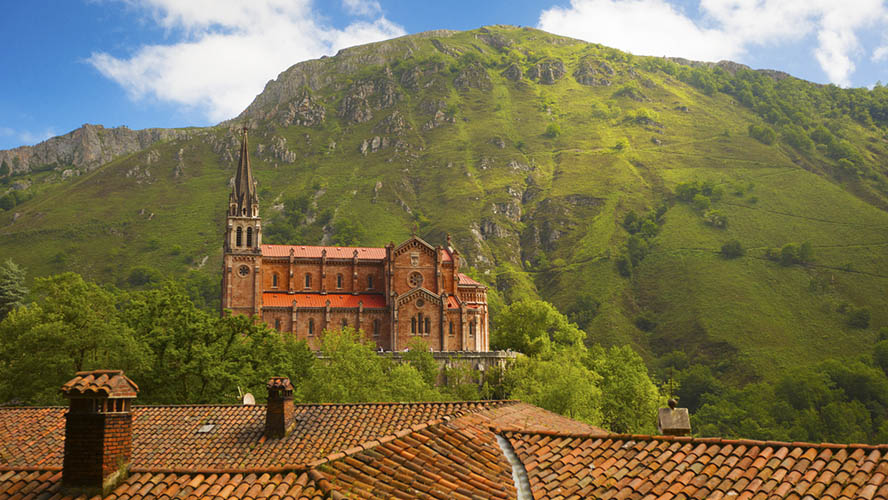
Descent of the River Sella, sport and celebration
The International Descent of the River Sella is one of the most important events in Asturias. It’s a popular festival that “disguises” itself as a canoeing competition. It has taken place since 1929 and is held every year, during the second weekend in August, on the stretch of river that runs between the towns of Arriondas and Ribadesella.
What was originally simply a race for Spanish and foreign canoeists over time has become a festival that involves both towns in the celebration, with various activities, processions of decorated cars, litres of cider, and music. The descent of the River Sella has become increasingly famous over the years, and today attracts competitors of up to 15 different nationalities. It’s one of the most important tourist events in the Principality.
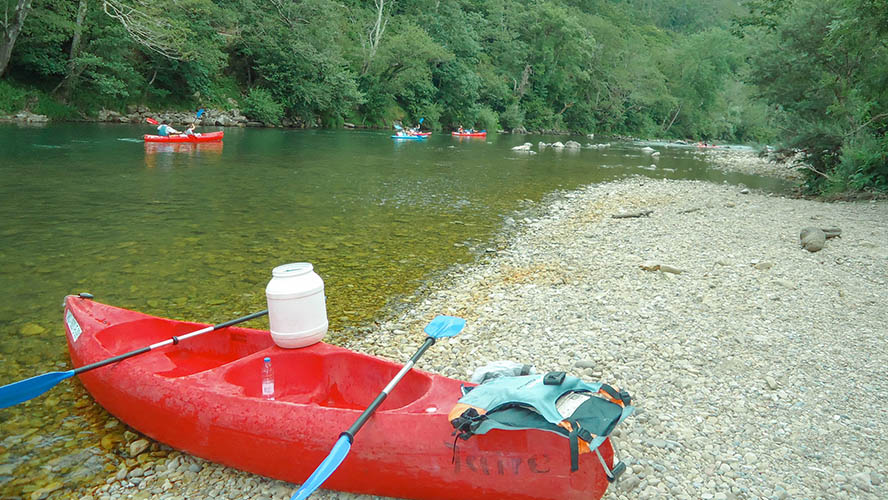
The sporting event begins at 12 noon on Saturday, when the canoes set off from Arriondas to Ribadesella. The fun, however, begins the day before. A river train connects the main locations. In the Campos de Oba, in Lloviu, a massive pilgrimage takes place in which typical Asturian food is shared alongside the prize-giving ceremony for the competition.
One of the great attractions of this sporting event is that anybody can do it, at an amateur level, any day of the year. It’s an ideal thing to do with friends or even with family. Leaving from Arriondas, you can choose a descent of 6, 10 or 14 kilometres, depending on your physical condition, your personal circumstances or how much time you have.
Taramundi, among traditions and nature
Taramundi is a municipality in the Principality of Asturias, on the border with the Galician city of Lugo. Its capital, which bears the same name, is the starting point for idyllic walks that enchant visitors. It’s hard to resist the magic of this region surrounded by rivers, among mountains and valleys. The constant murmur of the water and its calm rhythm make it an unbeatable destination for those who long to leave the hustle and bustle behind. But nature isn’t the only attraction offered by this land of mills, cutlers, and blacksmiths. Its architectural and cultural legacy, its museums, its handicrafts, and cuisine are added attractions for a visit to the area.
There is a lot to see in Taramundi. A pioneer in the field of rural tourism, this corner of Asturias delights hikers with varied routes. Bucolic landscapes, raised granaries, churches, hydraulic installations and a fort, one of the oldest in Asturias, await hikers. The church of San Martín, with its slender tower, rebuilt in the 18th century, stands out in the surrounding area. And very close by is La Rectoral, the old priest’s house.
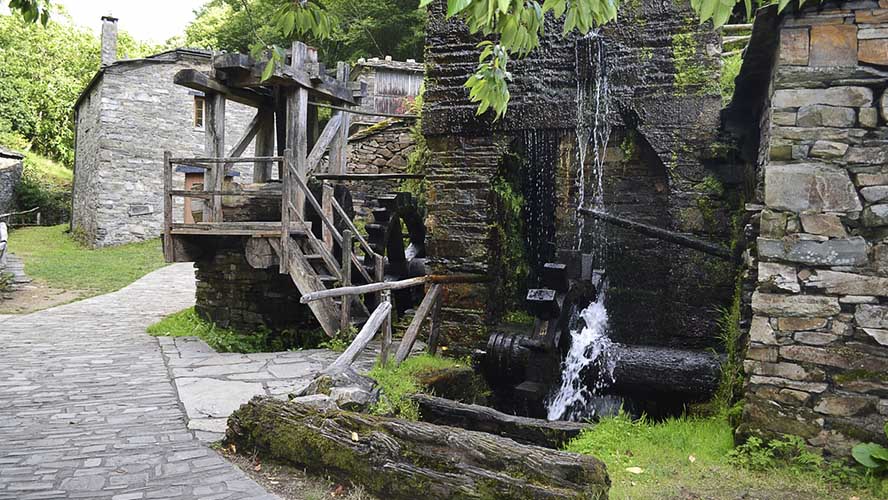
On the outskirts of the town, restless visitors can’t miss a visit to a very interesting enclave, the Taramundi fort, which is one of the most important in the Principality of Asturias. The findings of various digs have revealed the existence of a settlement from the end of the Bronze Age. The remains of a wall and various buildings, including a sauna, take us back to the 1st and 2nd centuries, the time of Roman occupation.
Another place well worth a visit is the small village of Os Teixos. Here you’ll find one of the oldest ethnographic sites in Asturias, a display of various hydraulic installations that will pique the interest of children and adults alike. Nor should you miss As Veigas, eight kilometres from the town of Taramundi. Located in the centre of the Oscos-Eo Biosphere Reserve, the village emerges at the bottom of a valley that you can reach along a winding mountain road. Its wooded landscapes and river make As Veigas an ideal destination. Fishing, canoeing, horse riding, and mushroom picking are some of its attractions, as well as the fact that it’s close to the beach.
Silencio Beach
The Asturian coast has kilometres of deserted beaches of white and golden sand. Here nature blends into the green of the mountains and the blue of the sea. The natural coves hide genuine dreamlike picture-postcard sights. Some are surrounded by cliffs, others by green vegetation, and some are even made up of magnificent rock formations. Some of the most beautiful beaches in Asturias are difficult to reach, which allows you to enjoy them virtually on your own.
Among the most outstanding is Silencio Beach, one of the most beautiful in Spain. It’s located in Castañeras (in the municipality of Cudillero) and, as its name “silence” suggests, it’s a quiet, secluded beach. To get there you have to follow a signposted dirt track and go down some 100 steps. It’s about 510 metres long and is surrounded by imposing cliffs. Take your own picnic and get ready to enjoy an unforgettable day.
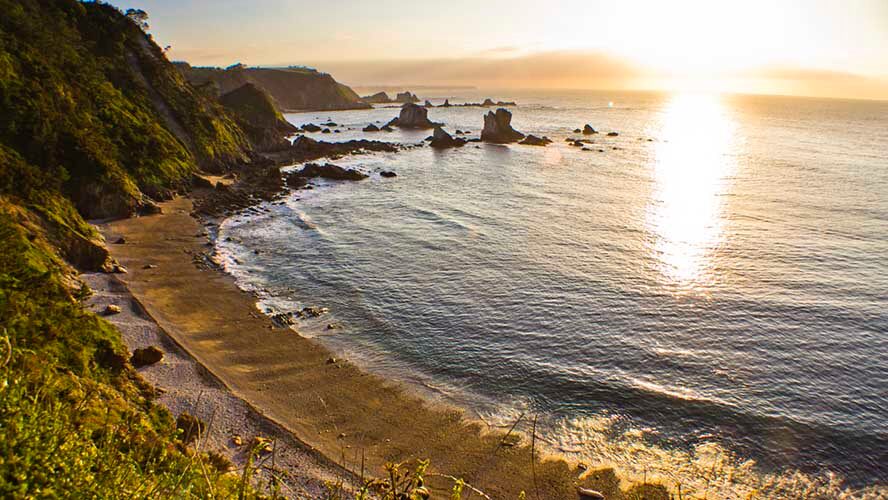
Gulpiyuri Beach
Just as appreciated as Silencio beach is the Gulpiyuri beach, declared a National Monument in 2001. It’s one of the most unique beaches in Asturias and one of the most sought after by visitors. What makes it such a special enclave is it seems far from the coast, and that isn’t what you’d expect from a beach. It’s also circular in shape, with about 50 metres of sand and is sheltered by cliffs and vegetation.
So, how does the water reach this beach? Quite simply, when the tide comes in, sea water enters through an underground conduit. It might appear to be a natural pool, but it isn’t, as it’s still affected by the high and low tides.
To see it you have to head to the town of Naves, in the municipality of Llanes.
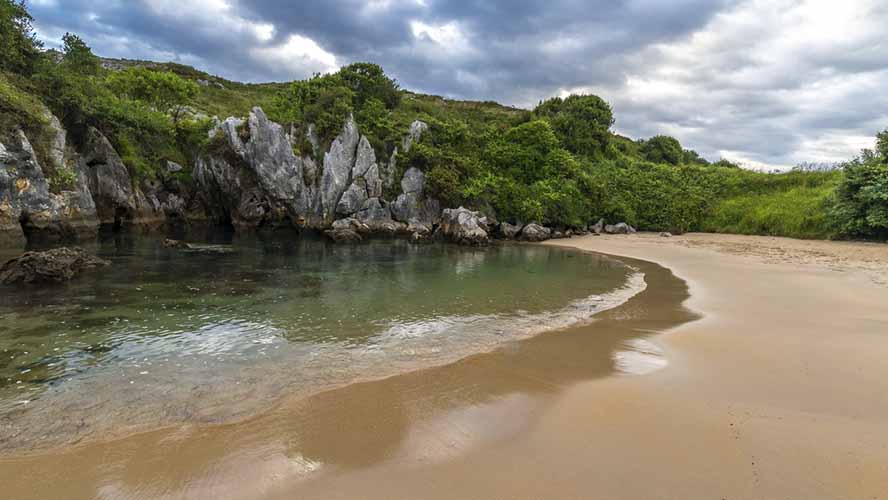
Other unmissable beaches in Asturias
To the list of recommended beaches in Asturias, we must add another selection of beautiful stretches of sand to Silencio beach and Gulpiyuri beach.
Visitors should be sure to not miss Torimbia beach, in Niembro (in the municipality of Llanes), in a protected landscape on the eastern coast. It’s a nudist beach, but welcomes all kinds of visitors. It’s 500 metres long and shell-shaped. It’s sheltered by enormous cliffs, making it a wild and virtually unspoilt beach.
Ballota beach is also a surprise along the Asturian coast.
You can find it in Cué (in the municipality of Llanes) and is another landscape protected due to its environmental importance. It’s a quiet beach with gentle waves and a very photogenic islet, Castro islet. And Rodiles beach, next to the mouth of the Villaviciosa estuary (in the municipality of Villaviciosa). It’s surrounded by a pine and eucalyptus forest and belongs to the Ría de Villaviciosa Nature Reserve. It’s one of the busiest beaches in summer and attracts surfers from all over Spain.
Also on the list is Cuevas del Mar beach, at the mouth of the Nueva river (in the municipality of Llanes), a protected landscape due to its vegetation and geological formations. Poó beach, next to the mouth of the river Vallina (in the municipality of Llanes), is considered to be one of the best beaches in Europe. And Andrín beach, in Andrín (in the municipality of Llanes).
And lastly, two more options: Penarronda beach, next to Santa Gadea (in the municipality of Castropol and Tapia de Casariego), which forms part of the Oscos-Eo Biosphere Reserve and has been designated a Natural Monument. And the Aguilar beach, in Muros de Nalón (in the municipality of the same name), where the Miradores route begins, a path that skirts the Asturian coastline to overlook the wild beaches from the top of the cliffs.
Bufones de Pría
An unmissable visit in Llanes is to the well-known Bufones de Pría. This is the name given to a natural phenomenon that occurs on the coast of Llames de Pría. This phenomenon is caused by the erosive effect of the sea and rain on the limestone rock. Due to the wear and tear they produce, cracks are created that connect the sea with the surface of the cliff. With the force of the waves, air or water is expelled through these conduits under extremely high pressure. To see it, you have to go to the town mentioned above. There is also a bufones route, which takes around four hours to complete.
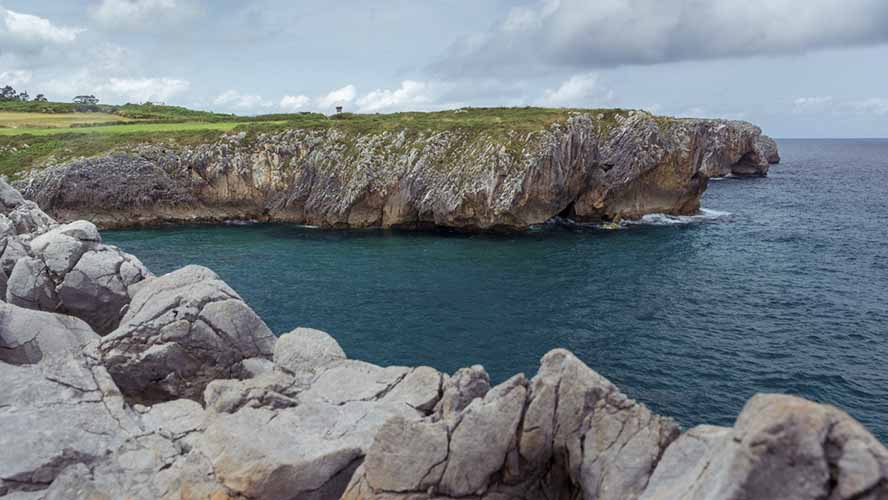
Essential cities and towns
Oviedo, a majestic city caught between yesterday and today
Oviedo, capital of the Principality of Asturias, is a city that stands out for its elegance and peaceful nature. Everything about it conveys a feeling of cleanliness, order, comfort, and a sense of history. It’s as if Clarín’s words in his famous novel La Regenta don’t quite ring true. In its pages the writer described this city as “ancient” and “extremely old, antiquated”. Time has passed and Oviedo has a new lease of life, adding new attractions to its traditional nature.
The city has become more modern and cosmopolitan. Hosting the Prince and Princess of Asturias Awards, which are given to important international figures, has contributed to this. But it still has the essence of yesteryear and it’s precisely this combination of yesterday and today that makes it so interesting. It’s this mix that filmmaker Woody Allen captured when he visited the city to receive the Prince of Asturias Award for the Arts. He described it as “a fairy tale town where everything is old, clean, and nice…”.
To this feeling, so well summed up by the New York director, we can add the care with which the people of Oviedo take care of their historical-artistic heritage. Allen, by the way, has a bronze statue, commemorating his stay, in calle de las Milicias Nacionales. The city preserves its treasures with care and doesn’t deny the past, but implements changes that enrich it. The recent opening of the city centre to pedestrians and the extension of the Museum of Fine Arts are proof of its progress.
There are many places of interest in Oviedo, the second most populous municipality in Asturias (after Gijón). In the old town, many statues will catch the eyes of visitors while they walk around. One of them is a statue of Ana Ozores, the protagonist of “La Regenta”. She appears very elegantly, with a book in her hands, in the Plaza de Alfonso II, in front of the Cathedral, an ideal place to stop and take in the pulse of the city.
The Oviedo Cathedral, erected in honour of San Salvador, is one of the great assets of the capital of the Principality. It dates from the 15th century and is Gothic in style, but this is mixed with elements of other architectural styles. It has a single bell tower, which gives it a unique appearance. The façade was designed by Juan de Badajoz. Inside, the chapel of Santa Bárbara and the altar of Santa Teresa stand out. The balcony where the Holy Shroud and the Holy Chamber are exhibited is also outstanding.
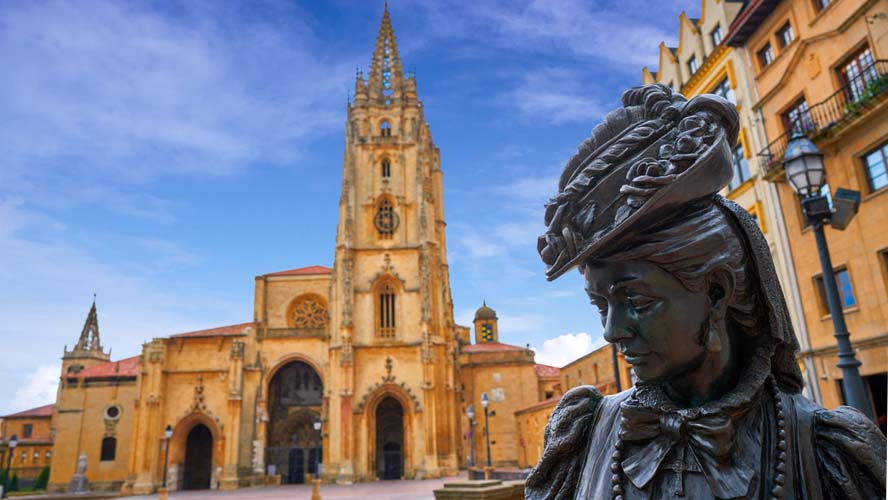
Nearby is the Asturias Museum of Fine Arts. It’s made up of two historic buildings: the 18th-century Velarde Palace and the 17th-century Casa de Oviedo-Portal. And a third, which has been expanded, was designed by the architect from Navarre, Francisco Mangado. In this space, visitors can enjoy outstanding works such as Jovellanos and the Portrait of Carlos IV, by Goya, or Christ on the Cross by Zurbarán. You can also stop to admire paintings by Regoyos, Sorolla, Nonell, and Ramón Casas, among other artists.
There are many attractions in the city, both in its old and new quarters. The historic quarter of Oviedo, with its maze of streets and its baroque and modernist façades, is well worth a leisurely stroll. In the vicinity of the Town Hall is the Fontán, a pretty little square with arcades surrounded by craft shops, cider bars, and a lively market. Churches, such as San Isidoro and Santa María la Real, can be found along the way. And historical buildings such as the University and palaces such as Valdecarzana palace, where today the Provincial Court is located, catch the eye.
It’s worth taking a walk along the Paseo del Espolón, where the Spanish emigrants who returned from America with great fortunes settled. And to take a break in beautiful parks such as Campo de San Francisco, where a sculpture pays homage to Clarín. Another lovely place in Oviedo is the Winter Park where you’ll find the open-air swimming pools of San Lázaro, the Children’s Palace, a skate park, and a labyrinth made up of 650 laurel trees. Those interested in hiking should know that the park links up with the Fuso de la Reina path.
Gijón, an interesting city behind the beach
The main image people have of Gijón, the one that sticks in the memory of those who visit it, is that of San Lorenzo beach. It measures a kilometre and a half in length and is the most popular place to have fun and to meet for the locals. It’s bordered by a stone wall along which the promenade stretches. The best way to take in the spirit of the city is to walk along it. It has 15 accesses leading down to the beach, with the best known being the Escalerona access. If the weather is good, it’s tempting to go for a swim or walk along the wet sand.
San Lorenzo is located between the church with the same name and the mouth of the river Piles. At one end of the beach stands the Church of San Pedro. And behind it the town rises. You have to discover its many places of interest once you’ve spent some time in or by the sea. San Lorenzo isn’t the only place to take a dip in Gijón. There are also other beaches such as Poniente beach, which is next to the marina and where the city’s Aquarium is located.
If there’s one place that delights visitors, it’s the old fishermen’s quarter of Cimadevilla. It’s a pleasure to lose yourself in its maze-like narrow stone streets and discover different places of interest. For example, the 18th-century Jovellanos Birthplace. Or the hill of Santa Catalina, overlooking the Bay of Biscay. This is the site of one of Eduardo Chillida’s most iconic works, In Praise of the Horizon. Here you can find the Plaza del Lavaderu, where the people of Gijón usually sit on the steps to have a glass of cider. As well as another popular meeting point, the Cuesta del Cholo. Here you’ll be surprised by the Cider Tree, a sculpture made from green bottles of the typical Asturian drink.
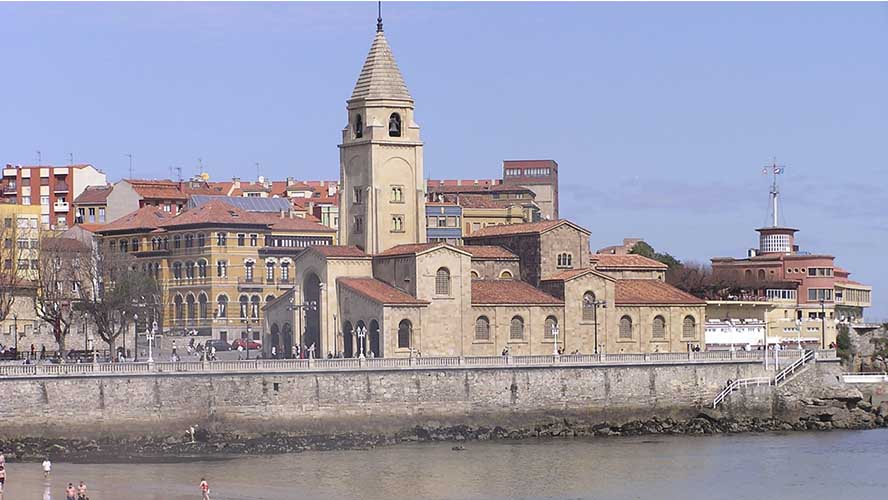
In the centre of the city, buildings such as the Revillagigedo Palace, in Baroque style, stand out. It’s located in the marina area, next to the Collegiate Church of San Juan Bautista, and serves as a cultural centre. The Plaza Mayor, where the Town Hall is located, is another of those corners where you can feel the pulse of the city. The same applies to the Plaza de San Miguel and calle Corrida, which is full of terraces. Culturally, Gijón offers interesting visits. The Jovellanos Theatre offers a varied programme. And there are museums such as the Barjola Museum, dedicated to the expressionist painter, and open for temporary exhibitions. Other artists born in the municipality also have centres that keep their legacies alive, such as Evaristo Valle and Nicanor Piñole.
Among cultural buildings of interest is the Pueblo de Asturias Museum, on paseo del Doctor Fleming. It’s dedicated to the ethnography of the region and its exterior features a recreation of an Asturian village with its bowling green, its granary, and its bread baskets. It provides a kind of journey into the rural world of yesteryear.
Located around three kilometres from the centre, it’s worth visiting the Old Labour University of Gijón, better known as Labour City of Culture, or La Laboral. Declared a World Heritage Site by Unesco, it’s housed in a monumental building (270,000 m2), with a classicist style, designed by Luis Moya. Its tall tower and its elliptical church, now deconsecrated, stand out. The complex contains a theatre with a Hellenistic façade and the LABoral Art and Industrial Creation Centre, among other institutions.
Opposite, you can find the Atlantic Botanical Gardens, a modern space of 25 hectares. The so-called Garden of the Island, a historic garden more than 150 years old is protected and cared for here, and you can find the Natural Monument of La Carbayeda del Tragamón, a natural forest with trees up to 400 years old.
Llanes, cliffs, beaches, and outstanding monuments
The small town of Llanes stands on the edge of the Cantabrian Sea, with the Picos de Europa in the background. Two geographical features that already define the beauty of this place, which seems to have been painted by an artist in shades of green and blue. The beauty of the landscapes and its important architectural heritage make this corner of Asturias a prime tourist destination.
Just 48 kilometres long and with a population of approximately 14,000 inhabitants, the municipality of Llanes has the longest coastline in Asturias. Among the geological features of the area are its rugged cliffs, the result of the same karst erosion that has formed the Picos de Europa. At the foot of these cliffs are many beautiful beaches. There are around 40 of them, and many of them are small, with sand that can appear and disappear depending on the tides.
Among the best known is Toró beach, which can be reached on foot from the town with the same name. And San Antolín beach, with its wild nature, is a favourite among surfers. From here you can walk to Gulpiyuri, one of the area’s hidden gems.
A walk along the beaches of Llanes is an adventure for visitors. This bucolic route awakens the senses. Poó beach, about 3 kilometres from Llanes, is an excellent option if you’re looking for a quiet place to go with children, especially if the tide is high. Torimbia beach offers spectacular scenery and nudism is permitted here. The beaches of Ballota and Cuevas del Mar are also highly recommended.
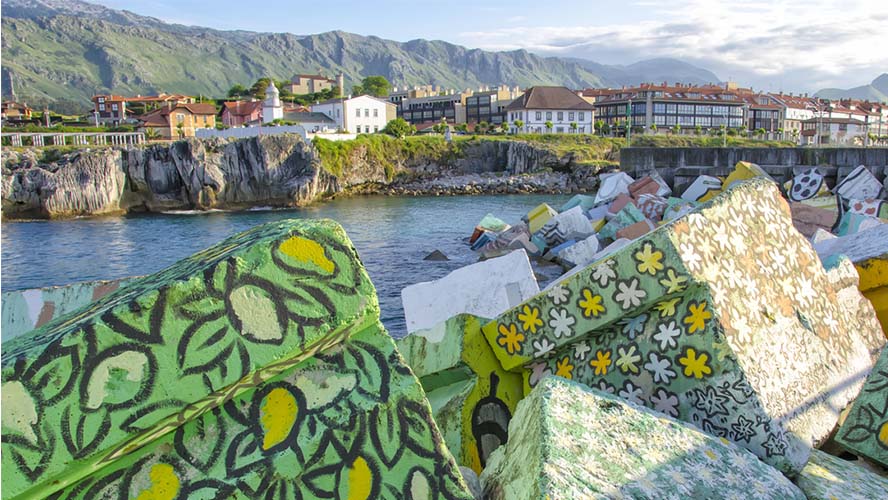
But, in addition to the beaches, in Llanes visitors should let themselves be enchanted by the town’s old quarter. Here you’ll find monuments that have been declared Sites of Cultural Interest. The town was founded in the late Middle Ages and among its many charms it still conserves a large part of its walls. Of particular note is the Llanes tower, a defensive structure made of limestone dating from the 13th century.
On a stroll through the town’s cobbled streets, a visit to the Basílica Menor de Santa María de la Asunción de Llanes is a must. It’s characterised by its mixture of Romanesque and Gothic styles and has a Plateresque altarpiece in the central nave. It’s also worth visiting Gastañaga palace, an elegant Gothic building, the chapel of La Magdalena, the Posada Herrera palace or the Casino building, which is clearly inspired by Modernism.
In the town there are two other routes that will captivate you. The first is the Paseo de San Pedro. This is a path built between the cliffs and covered by a grassy carpet, which runs along the edge of the town from the port. It’s a sort of natural walkway, through which you can see the whole medieval town without any obstacles. In the background, the Cuera mountain range seems to rise directly from the sea and, if the sky is clear, you can see as far as the Picos de Europa.
The second route leads us to the Cubos de la Memoria, the undisputed symbol of Llanes. This is an installation in the port created by Agustín Ibarrola. The artist used the concrete blocks of the enclave to create different artistic works with them. He painted them with different motifs and colours, playing with the effects of water and light. There are many feelings that captivate the visitor in this unique space. In fact, the whole of Llanes is an intense stimulus for the senses.
Cudillero, among the most beautiful villages in Spain
Cudillero, located on the central-western coast of Asturias, 50 kilometres from Gijón, always appears on lists of the most beautiful villages in Spain. Its staggered and colourful houses, its viewpoints, and its spectacular sea views make this small and beautiful village a jewel in the Principality’s crown.
The network of slopes is a characteristic feature of the layout of this town that has a marine essence. To learn more about the importance of the sea in its history, we recommend a visit to the Didactic Classroom “Los pixuetos y la mar”. It’s located in a former fish market in the Plaza de la Marina. It offers detailed information on the village’s history and traditions, also known as Villa Pixueta, which alludes to the Bable dialect spoken by its inhabitants.
After this introduction, you can follow the route of the viewpoints (there are eight in total). It’s an exhilarating experience that offers extraordinarily beautiful views of the entire area. Among the most common options is the Espera route. It consists of a walk through the village, passing by four viewpoints: the Pico, the Contorno, the Baluarte, and the Palación. The other most popular route is the Recorrido de los Barrios Pesqueros, which passes the viewpoints of Cimadevilla and La Estrecha.
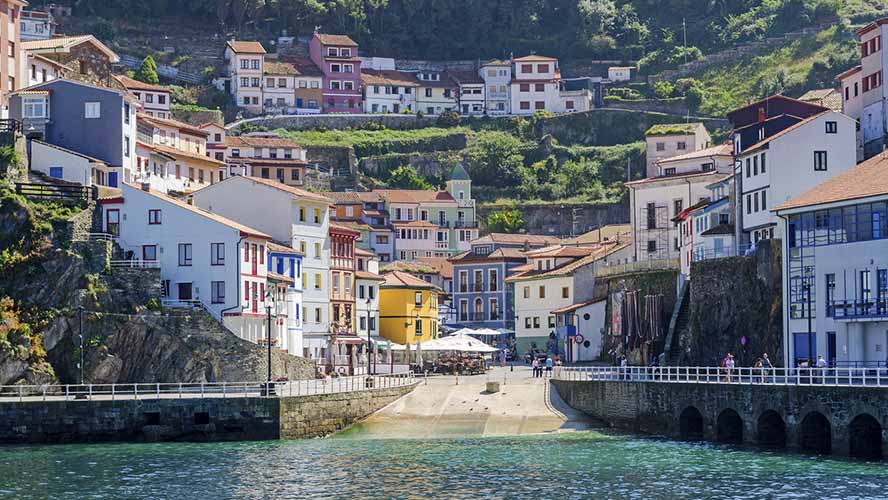
A visit to the lighthouse is also a worthwhile trip. It stands at Punta Roballera, at a height of 75 metres. It can be reached by climbing some steps from the seafront promenade and following a small path.
Once in the village, the different houses of those Spanish emigrants who made their fortune in America, such a common sight in Asturias, are worth a visit. Surprising buildings such as the Quinta de Selgas palace, commonly known as the Asturian Versailles. If there’s a meeting point for the locals, it’s the Plaza de la Marina, the famous multi-coloured square, or amphitheatre, as it’s affectionately known. If there’s one place that appears in photographs time and time again, it’s the old port, with its brightly coloured houses. In line with local traditions, each family painted their properties and their boat the same colour so that the townspeople could quickly identify them.
Another square, San Pedro, invites you to visit the parish church. And after climbing the steep slopes of the streets of San Juan and Salsipuedes, you’ll reach the oldest building in Cudillero, the chapel of El Humilladero, a small Gothic building from the 13th century. If the weather’s good, you can’t miss the chance to have a swim at one of the surrounding beaches. With crystal-clear waters, they appear among spectacular cliffs. The Silencio beach stands out, with its shell shape. And La Cueva beach, in the nearby town of Oviñana.
Cangas de Onís. History, spirituality, and nature
The Asturian town of Cangas de Onís is located in exceptional natural surroundings, which in turn is one of the great attractions of the municipality that bears the same name. The Picos de Europa, the river Sella, and the lakes of Covadonga are some of the places most popular with visitors to the area.
The Roman Bridge is well worth a visit as it’s one of the town’s most famous sights. It’s located over the river Sella and separates the municipalities of Cangas de Onís and Parres. The Victoria Cross, the icon of the Principality of Asturias, hangs from it. The Greek letters alpha and omega hang from its arms, symbolising the beginning and the end (the infinite extension of God).
Before leaving the village, you can visit the interesting chapel of Santa Cruz, a Catholic temple built on top of a dolmen. It pays homage to the Victoria Cross and is the burial place of Favila, the second king of Asturias, son of Don Pelayo and Queen Froiluba. It’s a good introduction before visiting the sanctuary of Covadonga.
A walk in the nearby Picos de Europa Nature Reserve is also a must. Located in the Cantabrian Mountains, it’s one of the best-preserved nature reserves in the world. Here you can enjoy a wide range of landscapes. Its fauna, featuring chamois, eagles, bears, and wolves, is a major attraction for animal lovers. The richness of its flora attracts both experts and the most curious of visitors.
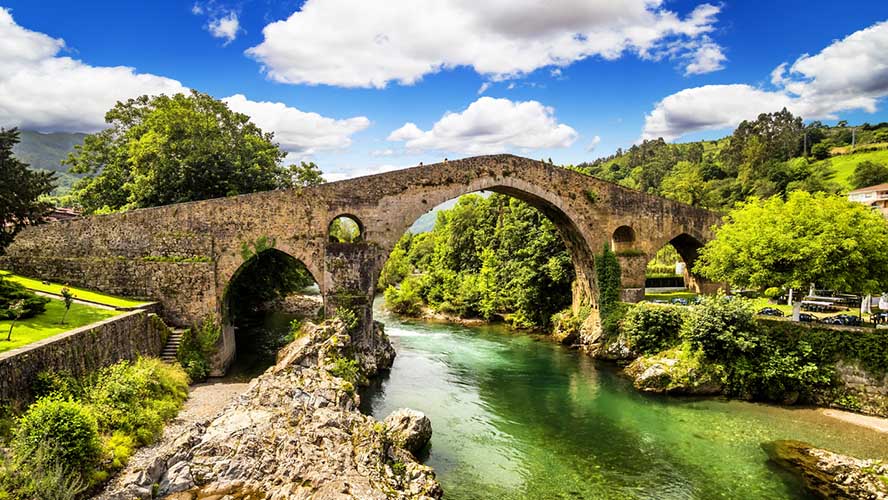
Ribadesella, a majestic town with cave paintings
Ribadesella, one of the main towns on the descent of the river Sella, opens out onto the Bay of Biscay. Between the sea and the meadows, the small fishing village is a charming corner of Asturias that is hard to leave once you get to know it. Village houses and beach hotels coexist in this peaceful town. Here, visitors are surrounded by peace and quiet, and are enchanted by the essence of bygone times in the elegant streets of the town centre, such as calle López Muñiz, and in squares such as Plaza María Cristina.
The splendour of other times is reflected in distinguished mansions such as that of Ardines mansion, with the coat of arms of an illustrious family of merchants, sailors, and soldiers as well as the Pixuecu mansion or Collado mansion, famous because the painter Darío de Regoyos was born there. The town hall is housed in the Prieto Cutre palace, which is an example of Renaissance style from the 15th century.
The city has many other attractions that invite you to stay longer. It has a marina and beaches as popular as Santa Marina, surrounded by palaces once owned by Spanish emigrants who made their fortune in America, now converted into hotels. A stroll through the old fishermen’s quarter, El Portiello, with its narrow streets, is well worthwhile. In this picturesque setting, the Escalera de Colores is particularly interesting, a staircase on which various residents, and sporting, cultural, and political representatives of the municipality have left their personal mark by painting a step and a phrase.
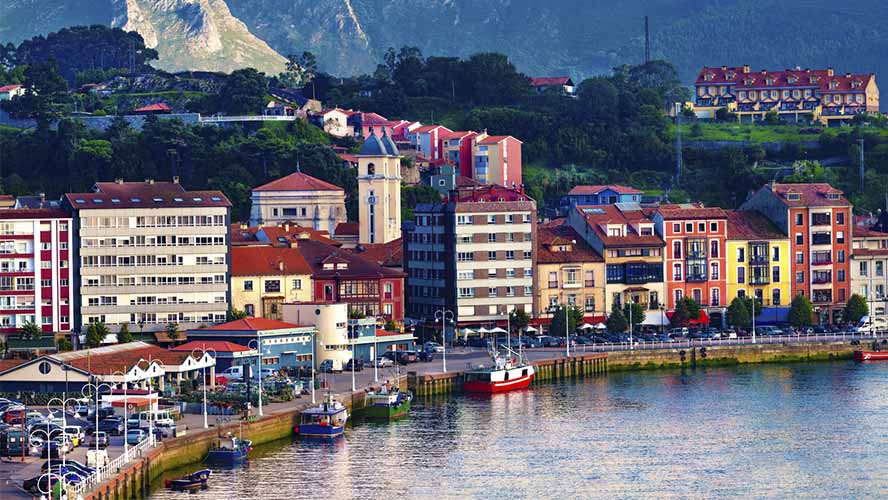
The municipality’s 80 kilometres offer beautiful routes such as the Molinos route and the possibility of visiting the Palaeolithic paintings in the Tito Bustillo cave. It’s home to one of the most valuable Palaeolithic cave paintings in the world. It was declared a World Heritage Site by Unesco in 2008. Engravings and zoomorphic paintings and other various technical and aesthetic artistic representations can be found in its 12 rooms. Visitors can only enter the most important one: the Main Panel room. The Cave Painting Centre provides visitors with comprehensive information on the area.
Avilés, much more than the Niemeyer Cultural Centre
For a long time, the main distinguishing feature of Avilés was its industrial nature. Being surrounded by the largest steel companies in Asturias helped to keep it out of the tourist spotlight. But that image has been consigned to the past. The Niemeyer Cultural Centre has given the city a strong international reputation and has placed it at the forefront of cutting-edge European cities. Avilés is no longer a grey, bland, and unknown place for tourists. Quite the contrary.
The Niemeyer Centre attracts many visitors. It’s a hub of attractions that encourages visitors to discover this Asturian town’s other undeniable charms. The old quarter, declared a Historic-Artistic Site in 1955, is one of the most charming urban centres in the Principality. It’s formed around the Plaza de Pedro Menéndez de Avilés and has outstanding pedestrian areas such as La Galiana or calle Rivero, full of arcades, which leads to the Plaza de España. The Town Hall and other palatial buildings are located here.
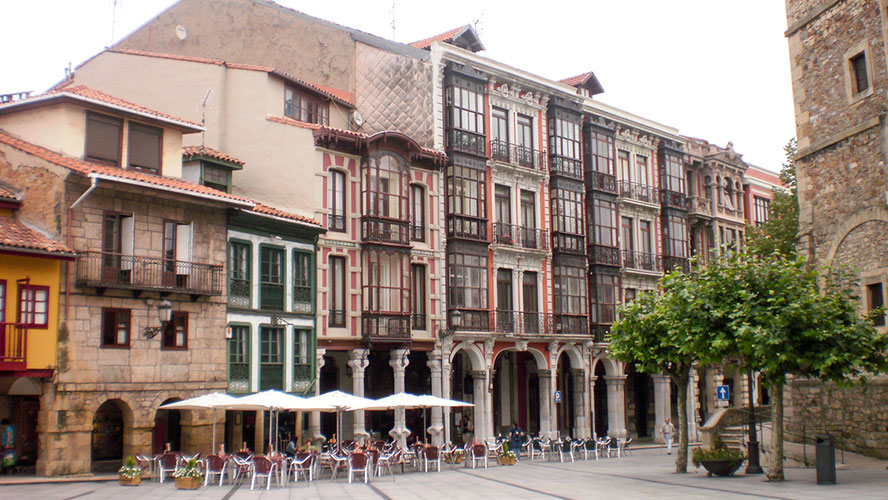
Other equally lively squares in the centre of Avilés are the Plaza del Mercado, surrounded by balconies and wooden arcades, and the Plaza del Carbayu, in the old fishermen’s quarter of Sabugo, a good place to relax with a drink on one of its terraces. If what you fancy is a stroll, you should head for the Parque del Puerto or the Parque de Ferrera, one of the most beautiful and picturesque parks in Asturias. It’s designed in the style of a British public park and, long before it was opened to the public, it was the hunting estate of the Ferrera palace.
Other outstanding buildings in the city include the Valdecarzana palace, the oldest civil building in Avilés (14th century), with a Gothic style, as well the Church of the Franciscan Fathers, a small Romanesque-style temple (12th century), a treasure of the city’s religious heritage. In the surrounding area, it’s well worth taking a stroll along the Ría de Avilés estuary. A natural estuary that connects the city with the sea, next to the town of San Juan de Nieva and its beautiful sandy beach. And, of course, a visit to the Niemeyer Cultural Centre is a must.
Luarca, the white town on the green coast
Luarca, capital of the council of Valdés, is a charming seaside town, known as “the white town on the green coast”, which captivates with its beautiful views and contrasts. Situated on the western coast of Asturias, 92 kilometres from Oviedo, it’s located between high mountain walls and is crossed by the river Negro, which splits the town centre in two and crosses seven bridges before flowing into the beach.
Luarca, a stop on Camino de Santiago [Way of St. James], offers visitors the colour and the hustle and bustle of its port, but also the serenity of its viewpoints, ideal places to enjoy the silence and admire the breathtaking beauty of the Bay of Biscay. It’s well worth strolling through its streets, among fishermen’s houses and elegant mansions of Spanish emigrants who made their fortunes in America.
A tour of the town includes visits to the port and the Mesa de Mareantes, a stone building that is reminiscent of the place where the old sailors debated whether to go out to sea depending on the changes in the weather. It’s located at the top of the typical fishermen’s quarter of Cambaral, with its staggered streets, picturesque properties, and the impressive views from the lighthouse, in calle Atalaya, where, between the 15th and 16th centuries, there was an old defensive fort designed to protect the town from pirate attacks.
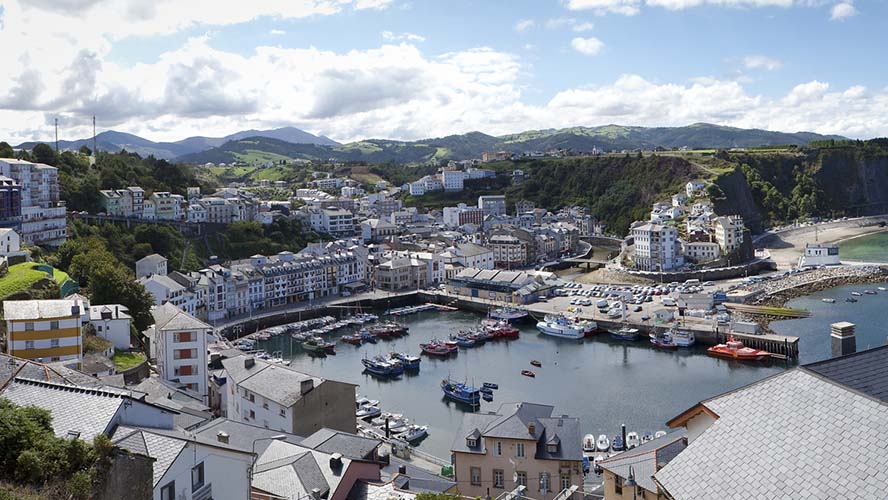
It’s also worth visiting the hermitage of the Virgen de la Blanca and the beautiful cemetery on the hill, with its spectacular views over the sea. One of the most illustrious residents of the Asturian town, Nobel Prize winner for Medicine, Severo Ochoa, is buried there. There’s a tourist route that takes in his favourite spots and offers a more personal and intimate view of the town.
Other points of interest in the town are the Fonte Baixa gardens, the largest private botanical garden in Spain, in the village of El Chano, which can be accessed from the fishermen’s neighbourhood. And the Parque de la Vida, a place dedicated to scientific dissemination and the preservation of the natural environment.
Luarca beach, in the vicinity of the port, is another of the top attractions of this corner of Asturias. Shaped like a shell, it’s sheltered by breakwaters and has some curious stones in the middle that separate it into two parts (Luarca 1 and 2). Other options for taking a dip in the area are Salinas beach, which can be reached on foot from the promenade, and Portizuelo beach.
Lastres, terraces overlooking the Bay of Biscay
Lastres, perched on terraces overlooking the Bay of Biscay, looks like a fairytale or film set. It’s impossible not to be captivated by the panoramic views from its elevated viewpoints, with the San Roque viewpoint being the most outstanding of all. It’s equally impossible to leave the place without having taken hundreds of photographs. Likewise when you visit the port area and the beach.
This town is also enchanting because of its cobbled streets, its houses with glazed balconies, its palaces and mansions with their façades decorated with coats of arms, its dark stone temples, and its clock tower. There are even many traces that suggest that dinosaurs once roamed the area, many of which can be seen in the unique Jurassic Museum, which is close to the town.
The aforementioned San Roque viewpoint is located in the so-called Campo de San Roque, presided over by the chapel of the same name, a small 17th-century temple in which the image of the saint, closely linked to the local fishermen’s guild, is venerated. A pilgrimage is held here every year, including a picnic, which takes place during a weekend in August.
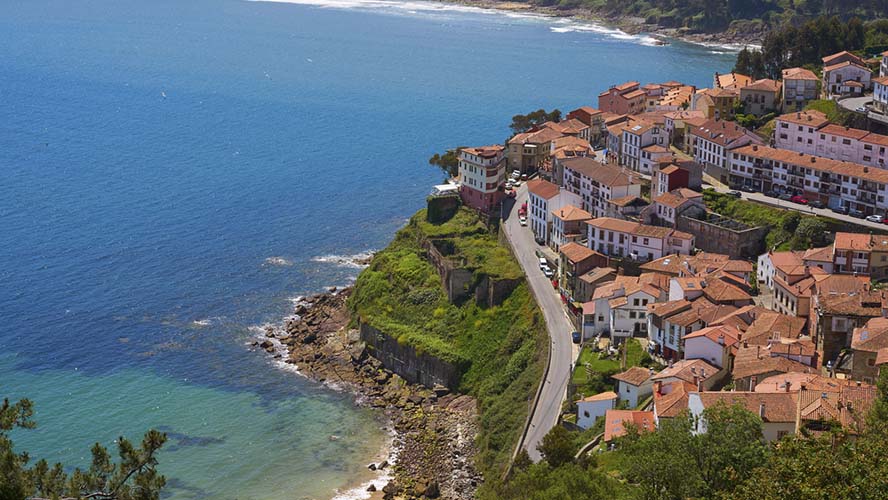
This watchtower is a must-see in the town, as is the beach, which is considered a protected landscape. Lastres beach is also known as Astilleru beach, which is a reference to the fact that this is where the whaling ships that were so important to the area’s economy in the past were made and repaired. That is, until the current fishing port was built.
Lastres has become more popular and more visitors thanks to the TV series “Doctor Mateo”, which aired in 2010. For five seasons, the characters played by Gonzalo de Castro, Natalia Verbeke, Álex O’Dogherty, Gorka Otxoa, Rosario Pardo, and María Esteve, among others, walked through the streets of this beautiful Asturian town. The local tourist office even designed the Doctor Mateo route, which leads to ten points in these parts.
Arriondas, the town of the Descent of the River Sella
The small village of Arriondas, capital of the municipality of Parres, is brimming with charm in streets and squares where architectural styles overlap. You can admire a church, such as the church of San Martín, which showcases Asturian Romanesque architecture, as well as mansions that have the typical style of 19th century properties owned by Spanish emigrants who made their fortunes in America, such as Villa Juanita or the Chalet de los del Valle (Casa Cepa). We suggest that you stroll through its streets while taking your time, and to discover beautiful places such as Concordia Park, one of the most popular meeting points for the locals. Along the way you’ll come across a number of parishes and beautiful small palaces. And if your trip falls on a weekend, it’s a good idea to visit Llera Park, where there’s a market with more than 20 stalls offering a little bit of everything.
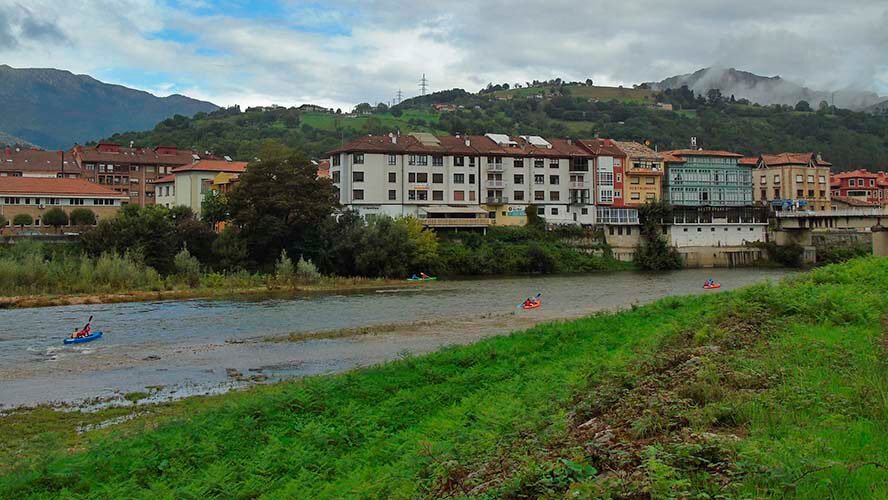
But make no mistake, most of the visitors who come to Arriondas do so because of its natural surroundings, which allows for countless excursions and one of the most famous activities in Asturias: the International Descent of the River Sella. This competition, which has a long history, began in 1933, continues to be held every year and attracts a large number of sportsmen and women. The river course for the competition is 20 kilometres long, but amateurs can do part of the route, either 6, 10 or 14 kilometres. Nobody can deny that this is a great plan for any summer.
Those who prefer the mountains will also find Arriondas a good starting point for interesting itineraries. One of the most popular is the route to Pico Pienzu, some five kilometres starting from the car park at the Fitu viewpoint and reaching the summit at an altitude of 1,161 metres. The walk and the views are well worth the effort. And to round off a weekend, you can include excursions to other iconic places in Asturias such as Cangas de Onís, Ribadesella, Lastres or the Basilica and cave of Covadonga.
Lastly, we must suggest that you have a gastronomic treat at the restaurant El Corral del Indianu, with its Michelin star that will give you a clue as to the quality of its cuisine. The Asturian José Antonio Campoviejo works magic with local produce using his creative genius.
Hiking in Asturias
The Cares Route, the best-known trail in Asturias
The Cares route is the best known trail in Asturias and probably in Spain. The route, originally laid out between impressive rock walls reaching an altitude of 2,000 metres, was originally designed for the workers of the Camarmeña hydroelectric power station. Over time, the route has become a favourite among hikers. It’s an excursion full of incredible beauty and suitable for almost everyone.
This corner of the Asturian mountains attracts hundreds of thousands of people from all over the world. Hikers can enjoy some of the most spectacular scenery in the Picos de Europa along the more than 12 kilometres of the route (almost 25 if you do the round trip). Most of the route runs parallel to the gorge of the river that gives it its name: the Cares. It’s often referred to as the Divine Gorge, as the almost magical beauty of the place is plain to see.
You can start this route from the León side, from the small village of Caín, or from the Asturian town of Poncebos. Several tunnels, opened on the river side, make the route very spectacular. The route also passes over three bridges (Los Rebecos, El Bolín, and the Camarmeña dam itself), from which you can admire the best and most spectacular views of the area.
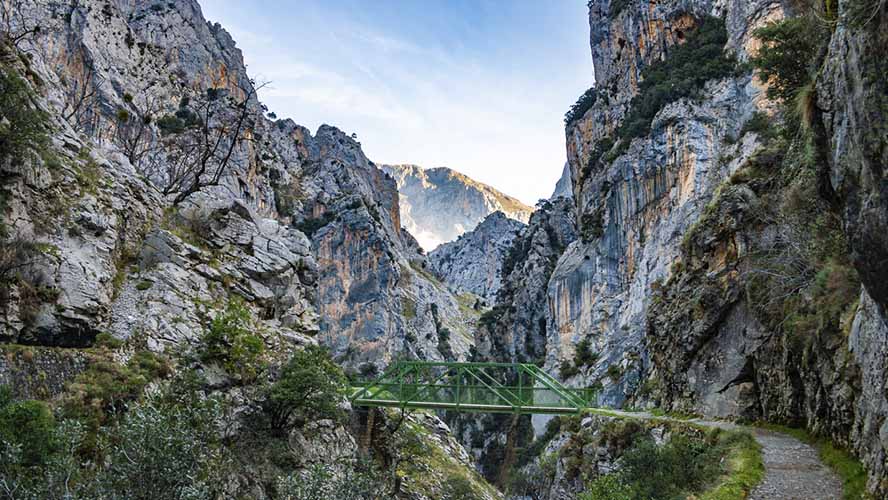
The Bear Trail
The popular Bear Trail started at the end of the 19th century as the path of a mining train that was in service for almost a century. Today, along with the Cares, it’s one of the most spectacular hiking (and cycling) routes in northern Spain. Those who dare to walk or cycle along the Bear Trail have almost 60 kilometres, between Tuñón and Cueva Huerta or Ricabo (there are two branches), to discover the wildest parts of natural Asturias. These are very close to the habitats of the brown bear, one of the Principality’s natural icons. In fact, the route passes next to the so-called Cercado de los Osos, where several specimens of captive-bred plant-eating bears have been living for years.
It’s a well signposted and marked trail, surrounded by lush vegetation. Walkers cross dense forests and wooden bridges that cross spectacular slopes and tunnels (with lights) through the mountains. Thousands of sportsmen and women and nature lovers take this route every year.
Among the places of interest along the route are the following: Tuñón, a pretty, typically Asturian village in which the Romanesque church of Santo Adriano de Tuñón (9th-12th centuries) stands out. Proaza, a small village where the bears live in the enclosure. The Valdemurio reservoir, one of the most popular recreational areas on the route and the Valdecerezales gorge, a route that has been traced over millions of years along the course of the river Teverga, with enormous granite rock walls.
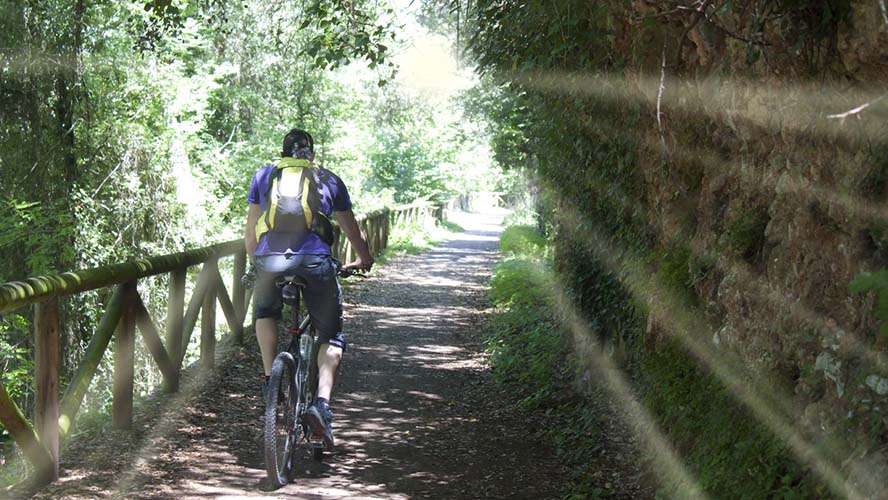
It’s worth visiting the Quirós Ethnographic Museum, located in part of what used to be the town’s old mining area. The smelting furnaces, to be precise. Here you can get an insight into the way of life before and after the arrival of mining to the area. Meanwhile, the Teverga Prehistoric Park offers a complete overview of the Upper Palaeolithic period, through reproductions of archaeological finds in different parts of Europe.
Routes in the Picos de Europa National Park
This park is one of the most important in the country for several reasons. Firstly, because it was the first to be declared a National Park in 1918 (although at that time it was called P.N. de la Montaña de Covadonga) and because it’s home to one of the most important sanctuaries in Spain. Lastly, because of its scenic and orographic qualities as well as its flora and fauna.
Visitors to this park, which is part of three autonomous communities (Castile and León, Cantabria, and the Principality of Asturias), should have a good idea of what they want to see or experience. There are free organised visits, accompanied by the park’s own guides. In Asturias, we must decide initially whether we want to do a hiking route or a high mountain route, which requires more physical effort.
Among the many hiking routes in Picos de Europa, some of the most popular ones are:
- The Cares Route, which is of medium difficulty and, if done in its entirety, is more than 20 kilometres long (about five and a half hours).
- The Lakes Route, which starts at the Buferrera car park and passes through the Pedro Pidal visitor centre, the Príncipe viewpoint, the Buferrera mine, lake Ercina, lake Bricial, the Palomberu beech forest, as well as the Enol meadow and lake Enol. The distance is five kilometres and can be done in two hours and a half.
- Route to the Naranjo de Bulnes peak or Urriellu peak, the most iconic peak in the park. It’s a hike of about 12 kilometres, with a difference in altitude of 900 metres. You’ll reach the base of this peak, which is over 2,500 metres high, but it’s enough to enjoy its magnificence.
In Picos de Europa, there are also other more complex Gran Recorrido routes, the GR201, the Senda del Arcediano, 27 kilometres long and of medium-high difficulty, and the GR 2020, the Ruta de la Reconquista, which runs for 58.6 kilometres and is of high difficulty.
If you’re going to embark on an unknown route, we recommend downloading the maps from the Picos de Europa National Park website to avoid major problems, or going on a guided tour for a safer and more educational experience.
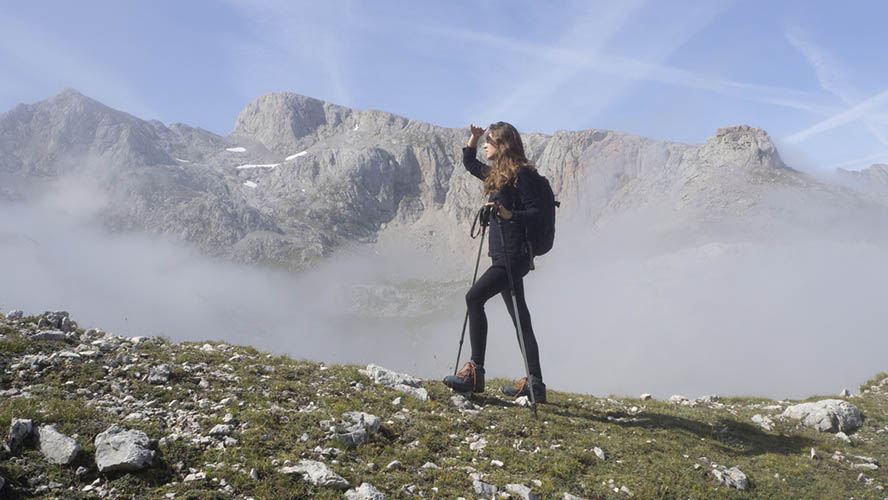
Redes Natural Park
Recognised as a Biosphere Reserve by Unesco in 2001, the Redes Natural Park is made up of an area of glaciers, caves, mountains, forests and peaks reaching up to 2,000 metres.
All of this combined makes for a very attractive area for hikes of varying degrees of difficulty, with no shortage of rivers and beautiful gorges. If you’re not sure which route is the most suitable, the best thing to do is to visit the interpretation centre, where they’ll help you and provide you with a map. Don’t miss the permanent exhibition and its audiovisual material.
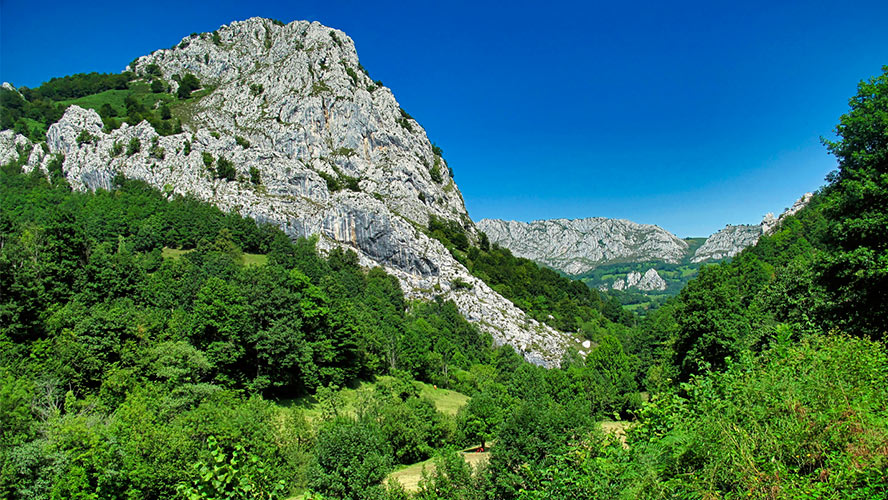
Among the easiest and most recommended routes are those that lead to three surprising Natural Monuments. One of them is the Ruta del Alba, which starts in Soto de Agues, follows the course of the river Alba showing its waterfalls and small rapids and reaches a gorge at the end of the path.
The second route that may be of interest ends at the Deboyu Cave, of karstic origin, and which has a depth of 200 metres. The river Nalón flows into it, a very unusual sight that can be seen from the Colorau bridge (the exit of the river is from the Deboyu bridge).
Lastly, and no less impressive, is the route that leads to the Tabayón del Mongayu. This is the name given to a waterfall of more than 50 metres that falls in a spectacular fashion. It’s located near the village of Tarna and can only be reached by walking along the PR.AS-60, which starts in Tarna and crosses a beech forest until it reaches the waterfall.
There are many hiking routes that you can find on the Redes Natural Park website.
The most important museums in Asturias
Fernando Alonso Museum
One of the places that’s a must for motor racing fans is the Fernando Alonso Museum. This sportsman, the first Spaniard to win a Formula 1 title, has a themed space with a display of 270 exhibits, including overalls, helmets, boots, trophies, and some of the single-seaters he has raced in since his childhood.

The museum is part of a much more ambitious sports complex with a sophisticated karting circuit, which can even host competitions, and the La Morgal Golf Course.
Jurassic Museum
The MUJA or Jurassic Museum is one of the essential visits on any family trip to Asturias. Its originality begins with its architectural design in the shape of a dinosaur’s tridactyl footprint and continues in its collection, which is very comprehensive and informative.
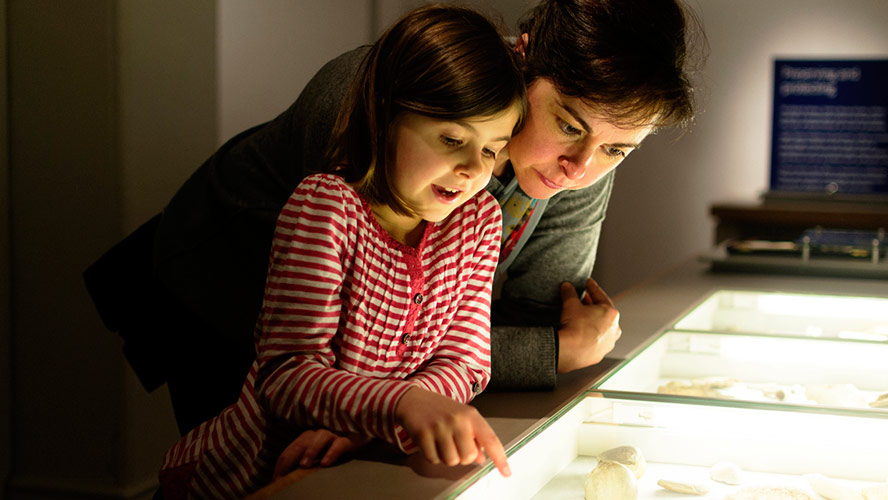
We suggest setting aside a morning or an entire afternoon to enjoy everything it has to offer in its 2,500 m2 sized space, where there’s no shortage of reproductions and skeletons. Children especially enjoy the garden, where there are 20 life-size replicas of these incredible prehistoric animals that lived millions of years ago. Its location in the San Telmo area (Colunga) isn’t a coincidence, as sauropod footprints have been found here.
Niemeyer Cultural Centre
This complex of modern architecture is the work of the brilliant Brazilian architect Oscar Niemeyer, who got to work on it after being awarded the Prince of Asturias Prize in 1989. It’s a group of geometrically shaped buildings whose whiteness stands out in the historic centre of Avilés. The contrast is even more striking when compared with the industrial architecture of the late 19th and early 20th centuries, which occupies a large part of the estuary next to which the town is located.
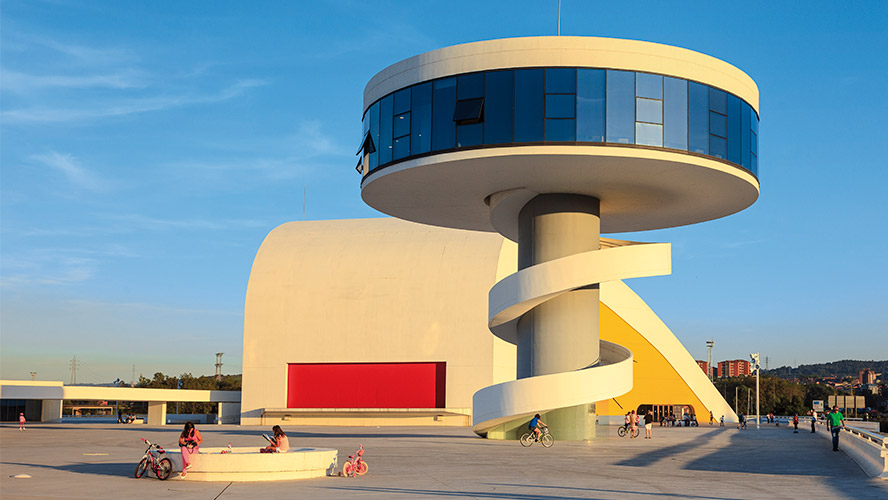
The building has become the setting for the city’s major cultural events. It houses, among other spaces, the Film Centre, meeting rooms and offices, a shop, an educational space, and also a gastrobar.
It also has an auditorium and a huge exhibition hall called La Cúpula, which hosts exhibitions of all kinds of arts and activities. The Tower, an 18-metre-high viewpoint over the estuary, is a highlight of the tour. It’s a must-see for art and architecture lovers.
Mining Museum
Few Spanish regions are as closely linked to mining as Asturias. For this reason, it’s a good idea to visit the town of El Entrego, in San Martín del Rey Aurelio, where tribute is paid to mining activity.
The Mining Museum can be seen as the guardian of the memory of this hard labour, as the tasks linked to the mines, machinery, minerals, etc. are spread over several rooms.
Its location has also been carefully chosen, as it’s very close to the historic San Vicente mine shaft, which was the first one to be self-managed by a mining union. The youngest of visitors will be attracted by some of the installations such as the cage or the reproduction of a mining shaft.
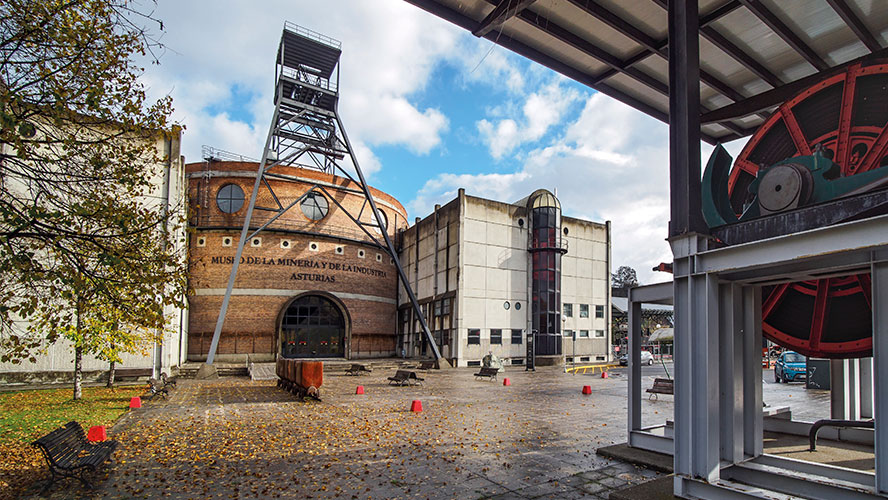
The visit can continue in other nearby places, which are also good examples of industrial tourism, such as the Sotón mine shaft, declared a Site of Cultural Interest, the Ecomuseum of the Samuño Valley, and the factory of the company Sociedad Metalúrgica Duro-Felguera.
At Barceló Experiences you can continue your journey through the charms Spain has to offer, by visiting our complete tourist guides to other must-see destinations such as Madrid, Cadiz, Valencia, Seville or Granada.




































































